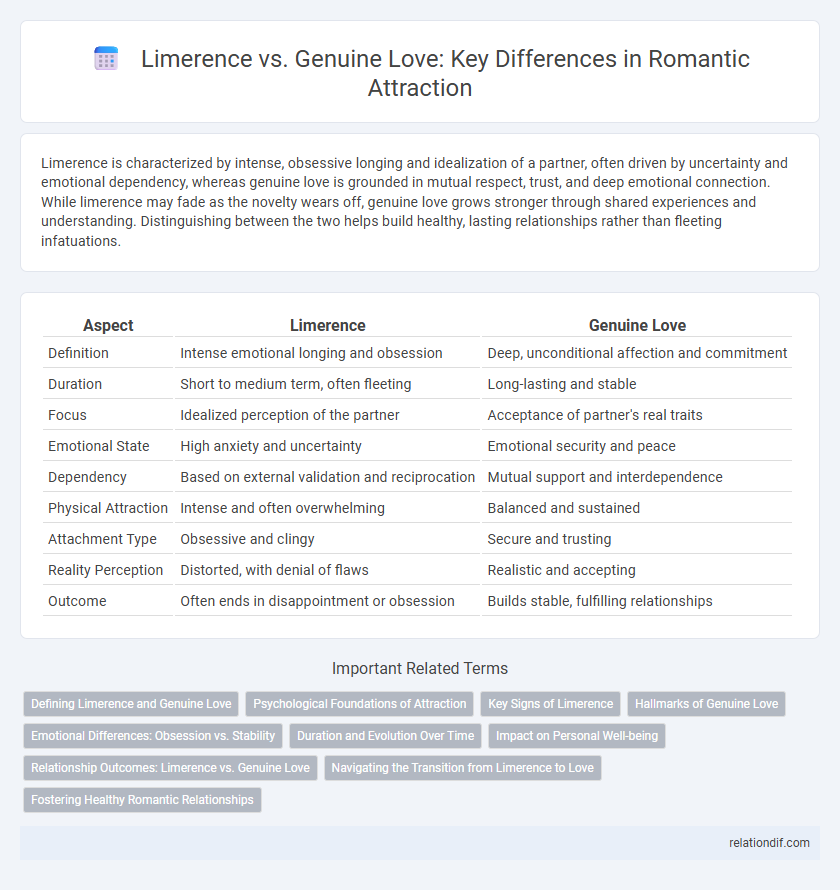Limerence is characterized by intense, obsessive longing and idealization of a partner, often driven by uncertainty and emotional dependency, whereas genuine love is grounded in mutual respect, trust, and deep emotional connection. While limerence may fade as the novelty wears off, genuine love grows stronger through shared experiences and understanding. Distinguishing between the two helps build healthy, lasting relationships rather than fleeting infatuations.
Table of Comparison
| Aspect | Limerence | Genuine Love |
|---|---|---|
| Definition | Intense emotional longing and obsession | Deep, unconditional affection and commitment |
| Duration | Short to medium term, often fleeting | Long-lasting and stable |
| Focus | Idealized perception of the partner | Acceptance of partner's real traits |
| Emotional State | High anxiety and uncertainty | Emotional security and peace |
| Dependency | Based on external validation and reciprocation | Mutual support and interdependence |
| Physical Attraction | Intense and often overwhelming | Balanced and sustained |
| Attachment Type | Obsessive and clingy | Secure and trusting |
| Reality Perception | Distorted, with denial of flaws | Realistic and accepting |
| Outcome | Often ends in disappointment or obsession | Builds stable, fulfilling relationships |
Defining Limerence and Genuine Love
Limerence is characterized by intense longing, obsessive thoughts, and a strong desire for reciprocation, often driven by idealization and uncertainty. Genuine love involves deep emotional connection, trust, acceptance, and commitment based on mutual understanding and realistic appreciation of each other's strengths and flaws. Unlike limerence, genuine love fosters stability, emotional security, and lasting intimacy beyond initial infatuation.
Psychological Foundations of Attraction
Limerence is characterized by intense, obsessive desire and intrusive thoughts rooted in dopamine-driven reward circuits, whereas genuine love involves sustained emotional intimacy and attachment regulated by oxytocin and vasopressin pathways. Psychological foundations of attraction highlight that limerence often stems from an idealized perception and uncertainty, triggering anxiety-reward cycles, in contrast to genuine love's basis in secure attachment styles and mutual trust. Understanding these neural and emotional mechanisms clarifies why limerence is transient and emotionally turbulent, while genuine love fosters long-term bonding and psychological well-being.
Key Signs of Limerence
Key signs of limerence include obsessive thoughts about the object of affection, intense emotional highs and lows depending on perceived reciprocation, and a strong desire for emotional reciprocation rather than physical intimacy. Individuals experiencing limerence often exhibit idealization of their love interest, difficulty concentrating on other tasks, and anxiety over interactions or lack of communication. Unlike genuine love, limerence is characterized by dependency on external validation and a focus on the fantasy of the relationship rather than its reality.
Hallmarks of Genuine Love
Genuine love is characterized by deep mutual respect, unconditional support, and a consistent sense of trust between partners. It fosters emotional intimacy, allowing individuals to grow and thrive together without dependency or idealization. Unlike limerence, genuine love remains steady over time, rooted in reality rather than infatuation or obsessive longing.
Emotional Differences: Obsession vs. Stability
Limerence is characterized by intense obsession, emotional highs, and dependency on reciprocation, often leading to anxiety and irrational thoughts. Genuine love fosters emotional stability, deep connection, and mutual respect, promoting security and trust between partners. The emotional differences lie in limerence's volatility versus genuine love's consistent and grounded affection.
Duration and Evolution Over Time
Limerence typically lasts from a few months to about three years, characterized by intense, obsessive attraction and idealization of the other person. Genuine love evolves gradually, deepening over time through mutual understanding, trust, and emotional intimacy, often enduring for decades. Unlike limerence, genuine love maintains stability and grows stronger despite challenges and changes in circumstances.
Impact on Personal Well-being
Limerence often triggers intense emotional highs and obsessive thoughts, which can lead to anxiety and emotional instability, negatively affecting personal well-being. Genuine love fosters emotional security, mutual respect, and long-term commitment, contributing to greater psychological health and life satisfaction. Understanding these differences helps individuals cultivate healthy relationships that support mental and emotional resilience.
Relationship Outcomes: Limerence vs. Genuine Love
Limerence often leads to unstable relationship outcomes characterized by intense emotional highs and lows, driven by obsession and idealization rather than reality. Genuine love fosters long-term stability and mutual growth, underpinned by deep trust, commitment, and realistic acceptance of each partner's flaws. Studies show relationships grounded in genuine love exhibit higher satisfaction, resilience, and longevity compared to those dominated by limerence.
Navigating the Transition from Limerence to Love
Navigating the transition from limerence to genuine love involves recognizing the difference between intense infatuation characterized by obsessive thoughts and the deeper, enduring bond marked by mutual respect and emotional intimacy. Developing clear communication and fostering trust can help transform the initial emotional highs of limerence into stable, lasting love. Emphasizing consistent support and acceptance ensures that attraction evolves beyond idealization to a meaningful partnership.
Fostering Healthy Romantic Relationships
Limerence involves intense, often obsessive longing characterized by idealization and dependence on reciprocation, while genuine love is rooted in mutual respect, trust, and emotional stability. Fostering healthy romantic relationships requires recognizing limerence symptoms such as intrusive thoughts and emotional volatility to shift towards authentic connection. Emphasizing open communication, empathy, and shared values strengthens bonds beyond the fleeting intensity of limerence.
Limerence vs Genuine Love Infographic

 relationdif.com
relationdif.com